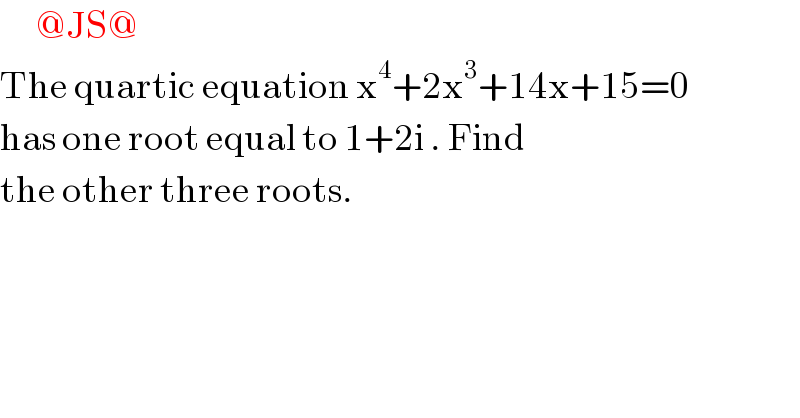
Question and Answers Forum
Question Number 106637 by john santu last updated on 06/Aug/20

Answered by bemath last updated on 06/Aug/20
![_(@bemath@) as the coefficient of the quartic are real; it follows that 1−2i is also a root. then [x−(1−2i)][x−(1+2i)] is a factor of the quartic. ⇒x^2 −2x+5 . Therefore x^4 +2x^3 +14x+15=(x^2 −2x+5)(x^2 +ax+b) and we get a = 4 and b = 3. p(x)=(x^2 −2x+5)(x^2 +4x+3)=0 → { ((x_(1,2) =((2±4i)/2) = 1±2i)),((x_(3,4) =((−4±2)/2)=−2±1)) :}](Q106640.png)
Commented by john santu last updated on 06/Aug/20

| ||
Question and Answers Forum | ||
Question Number 106637 by john santu last updated on 06/Aug/20 | ||
 | ||
Answered by bemath last updated on 06/Aug/20 | ||
![_(@bemath@) as the coefficient of the quartic are real; it follows that 1−2i is also a root. then [x−(1−2i)][x−(1+2i)] is a factor of the quartic. ⇒x^2 −2x+5 . Therefore x^4 +2x^3 +14x+15=(x^2 −2x+5)(x^2 +ax+b) and we get a = 4 and b = 3. p(x)=(x^2 −2x+5)(x^2 +4x+3)=0 → { ((x_(1,2) =((2±4i)/2) = 1±2i)),((x_(3,4) =((−4±2)/2)=−2±1)) :}](Q106640.png) | ||
| ||
Commented by john santu last updated on 06/Aug/20 | ||
 | ||